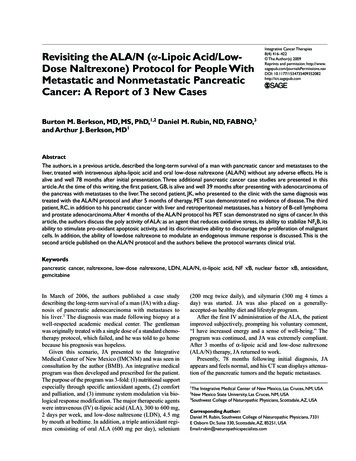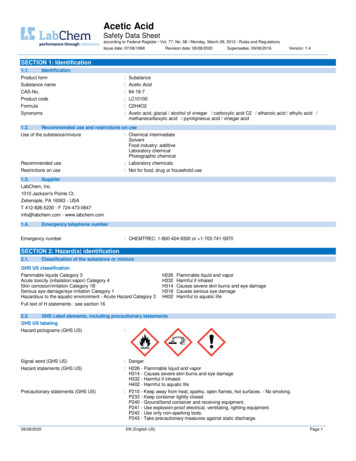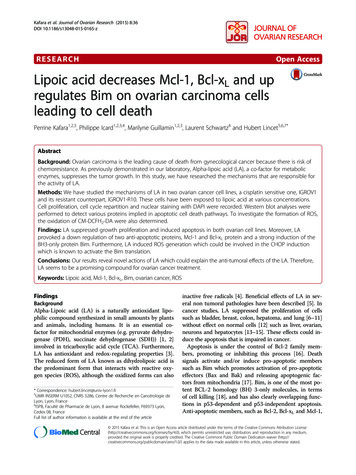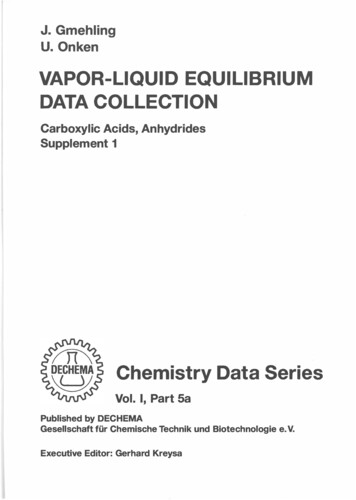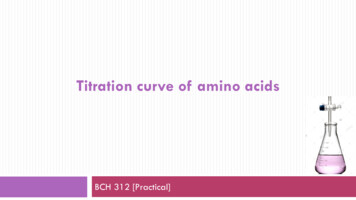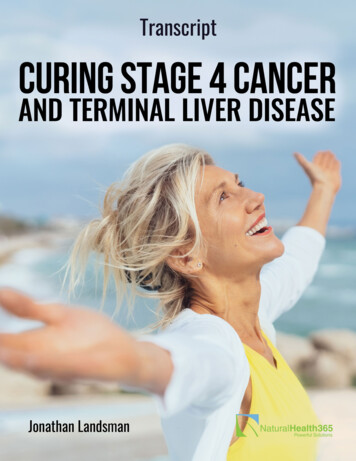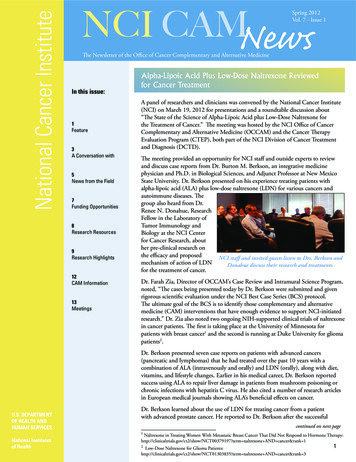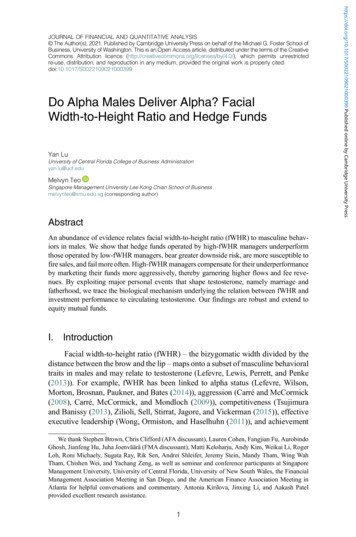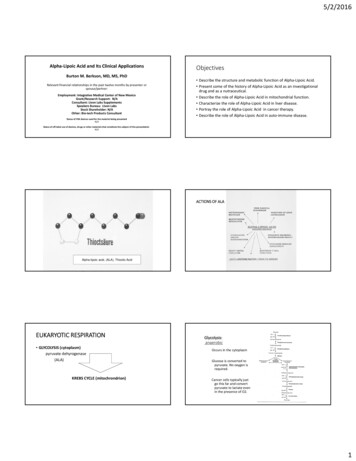
Transcription
5/2/2016Alpha‐Lipoic Acid and Its Clinical ApplicationsBurton M. Berkson, MD, MS, PhDRelevant financial relationships in the past twelve months by presenter orspouse/partner:Employment: Integrative Medical Center of New MexicoGrant/Research Support: N/AConsultant: Livon Labs SupplementsSpeakers Bureau: Livon LabsStock Shareholder: N/AOther: Bio‐tech Products ConsultantObjectives Describe the structure and metabolic function of Alpha‐Lipoic Acid. Present some of the history of Alpha‐Lipoic Acid as an investigationaldrug and as a nutraceutical. Describe the role of Alpha‐Lipoic Acid in mitochondrial function. Characterize the role of Alpha‐Lipoic Acid in liver disease. Portray the role of Alpha‐Lipoic Acid in cancer therapy. Describe the role of Alpha‐Lipoic Acid in auto‐immune disease.Status of FDA devices used for the material being presentedN/AStatus of off‐label use of devices, drugs or other materials that constitute the subject of this presentationN/AACTIONS OF ALAAlpha-lipoic acid, (ALA), Thioctic AcidEUKARYOTIC RESPIRATION GLYCOLYSIS (cytoplasm)pyruvate dehyrogenase(ALA)KREBS CYCLE (mitochrondrion)Glycolysis:anaerobicOccurs in the cytoplasmGlucose is converted topyruvate. No oxygen isrequired.Cancer cells typically justgo this far and convertpyruvate to lactate evenin the presence of O2.1
5/2/2016Krebs CycleAlpha lipoic acid is fundamental,for the conversion of food to energy.It is my understanding that ALA is the rate‐limiting agent for the production ofenergy from food in aerobic cellsGlycolysisanaerobic ALAOccurs in themitochondrionIn the presenceof oxygenaerobicPyruvate DehydrogenaseComplexKorotchkina LG, Sidhu S, Patel MS.Lipoic acid inhibits mammalian pyruvate dehydrogenase kinase.Free Radic Res. 2004 VATEPDHALPHA‐LIPOIC ACIDPyruvate Dehyrogenase Kinase (PDK) inhibits the enzyme complex (PDH)that convertsPyruvate into Acetyl CoAACETYL CO AAlpha Lipoic Acid decreases the rate of action ofPyruvate Dehyrogenase KinasePyruvate dehydrogenasekinase inhibits PyruvateDehydrogenaseSutendra G, Kinnaird A, Michelakis EDNuclear pyruvate dehydrogenase complex is importantfor the generation of acetyl‐CoA and histone acetylation.Cell. 2014 Jul 3;158(1):84‐97.More available PyruvateDehyrogenaseresults in increasedPyruvatebeing directed into theKrebs Cycleover the conversion ofPyruvate to LactateAlpha Lipoic Acid is important for theacetylation of histones in the cell nucleus.Alpha Lipoic Acid helps repair DNA2
5/2/2016Since a young personproduces enormous amounts of ALA,what happens when you feed a Thanksgiving dinnerto a 2 year old child;or an 80 year old man?What if a mitochondrion receives too much ALA?Lipoic acid LD50 Studies by Drs Vigil and Couch.Couch RC, Vigil M. et al. A dose escalation toxicity study of DL‐6‐8thioctic acid (lipoic acid) in Rhesus monkeys. 1997. Poster display.Annual Meeting Society of Toxicology.LOE BHealthy primate mitochondrion (hepatocyte) Following these studies I was asked to observe thenecropsies and perform the electron microscopy workon the damaged tissues at NMSU. I observed extensive necrotic lesions in the liver,kidneys, heart, and the large muscles of theextremities.Primate hepatocyte mitochondria following a LD50IV lipoic acid dose ofabout 90mg/kgMitochondria from animals who had received excessively highdoses of ALA became extremely edematous, anddemonstrated a disruption of all the crucial structures.These mitochondria did not exhibit the regular doublemembrane wall structure, but showed a coalescence ofthese structures with a deliquescence of membranes thusexhibiting a complete disruption of normal ultrastructure.3
5/2/2016LIVER MITOCHONDRIA SUFFERED SEVERE STRUCTUAL DAMAGEBY EXTREMELY HIGH DOSES OF INTRAVENOUS ALPHA LIPOIC ACIDGlobal Advances in Health and Medicine January,2014, volume 3number 1Michael Vigil MDAdjunct Associate Research Professor, Department of Biochemistry NMSUBurton M. Berkson MD MS PhDFormer Assistant Professor, Rutgers UniversityFormer Associate Professor, Chicago State UniversityFounder, The Integrative Medical Center of New MexicoAdjunct Professor, NMSUAdjunct Professor Oklahoma State Univ. College of Medicinebberkson@nmsu.edu(corresponding author) In reality, much lower doses of IV lipoic acid may causeserious bouts of hypoglycemia and the doctor and nursemust at all times watch carefully for possible problems.Ana Patricia Garcia DVM MS PhDAssociate Research Professor and Veterinary Pathologist YerkesAssistant Professor, Department of Pathology and Laboratory MedicineEmory University School of MedicineWith appropriate ALA levels, the mitochondrionfunctions normally.If the mitochondrion does not obtain sufficient ALA, itsuffers,and the organism dies.It is interesting to note that therapeutic doses of intravenousALA helps a liver regenerate but extremely high doses of thesame agent causes liver necrosis.Of course, excessive and unreasonable amounts of anysubstance given intravenously can be lethal, including waterand salt.If the mitochondrion is supplied with excessive amounts of ALA,it accelerates aerobic respiration and the process runs aheadof the other necessary constituents.The mitochondrion heats up, free radicals accumulate, and itsmembranous components break down.Severe damage to the mitochondrion is first seen by grossswelling and then severe damage to the cristae and matrixmaterial.Does ALA help regenerate livers?1st large scale clinical trial with IV alpha‐lipoic acid atNIH.(Bartter, Berkson, et. al. 1977‐1980)B4
5/2/2016We reported in 3 publications that we treated 79people waiting for liver transplant surgery (acutehepatic necrosis) and 75 regenerated their liverswith just the administration of intravenous Alpha‐lipoic acid.I was appointed by the FDA principal investigator for alphalipoic acid as a prescription drug in 1983. That lasted 23 years.Bartter FC, Barry Rumack, and Berkson B 1978As visiting scientists at the Max Planck Institute in HeidelbergBOur first paper.Should have been titled ALA reverses Acute Hepatic NecrosisCIRRHOTIC LIVERIf IV ALA reverses acute liver disease, will it reversechronic liver disease, for examplehepatitis C?5
5/2/2016GERMAN JOURNAL OF INTERNAL MEDICINE ARTICLEBerkson BM. A conservative triple antioxidant approach to the treatment ofhepatitis C. Combination of alpha lipoic acid (thioctic acid), silymarin, andselenium.Med Klin (Munich). 1999 Oct 15;94 Suppl 3:84‐9.I took 3 cirrhotic hepatitis C patients in the process of liver transplantevaluation at University Hospital and administered ALA, silymarin andselenium (inhibition of replication).The 3 recovered normal liver function within 6 months.Conclusion of my 1999 paper.I offered a more conservativeapproach to the treatment ofhepatitis C,that is exceedingly lessexpensive. Oneyear of the triple anti-oxidanttherapy describedin this paper costs less than 3,000, as compared to morethan 500,000 a year for livertransplant surgery.BAre there other diseases that ALA might help?Smith AR, Shenvi SV, Widlansky M, et al. Curr Med Chem. 2004May;11(9):1135-46.)Lipoic acid is a potential therapy for chronic diseasesassociated with oxidative stress.Most chronic diseases are associated with OS.BLipoic Acid prevents ischemiareperfusion injuryPanigrahi M, Sadguna Y, Shivakumar BR, Kolluri SV, RoyS, Packer L, Ravindranath V. Brain Res. 1996;717(12):184-188. -Alpha-Lipoic acid protects againstischemia reperfusion injury followingcerebral ischemia.BBWhat about ALA and diabetes?Suh JH, Shigeno ET, Morrow JD, et al. Faseb J. 2001;15(3):700-706.Oxidative stress in the aging rat heart is reversedby supplementation with alpha-lipoic acid.BJacob S, Henriksen E, Schiemann A. et al.Enhancement of glucose disposal in patients with type 2 diabetesby alpha-lipoic acid.Arzneimittel-Forschung 1995, 45(8):872-874.Henriksen et al. published the first human study toshow that ALA increases insulin stimulated glucosemovement into the cell, and out of the bloodstream, in diabetes.B6
5/2/2016Tankova T, Cherninkova S, and Koev D.Treatment for diabetic neuropathy with IV alpha-lipoic acid.Int J Clin Pract. 2005 Jun;59(6):645-50.What about ALA and cancer?This study demonstrated that alpha-lipoic acid is aneffective treatment for peripheral and autonomic diabeticneuropathy and also diabetic neuropathy of the cranialnerves leading to full recovery of the patients.At the Integrative Medical Center of New Mexico, we treatdiabetic neuropathies with IV ALA every day."All hallmarks of cancer including the Warburg effect can belinked to impaired respiration and energy metabolism,“ Theseare "downstream effects of damaged mitochondrial function."Thomas SeyfriedCancer As a Metabolic Disease(Wiley, 2012)Warburg O. The chemical constitution of respiration ferment. Science.1928;68:437–443.Science.68.1767.437.BShi DY, Liu HL, Stern JS, Yu PZ, Liu SL.FEBS Lett. 2008 May 28;582(12):1667‐71.Kisurina‐Evgen'eva OP, Onishchenko GE.Alpha‐lipoic acid triggers elimination ofcells with abnormal nuclei in humancarcinoma epidermoid cell lineTsitologiia. 2010;52(3):225‐34.Wenzel U, Nickel A, and Daniel H.Alpha-Lipoic acid induces apoptosis in human colon cancer cells byincreasing mitochondrial respiration which results in O2-*-generation.Apoptosis. 2005 Mar;10(2):359-68This study provided evidence that ALA and itsreduced form can induce cancer cell death by aprooxidant mechanism that is initiated by anincreased uptake of oxygen into themitochondrion.Alpha‐lipoic acid inducesapoptosis and necrosis inhepatocellular carcinoma cells.BAlpha‐lipoic acid not onlytriggered apoptosis of carcinomacells, but it also activated themechanism of elimination ofother cells with abnormalchromosome number.Na MH, Seo EY, Kim WK Nutr Res Pract. 2009 Winter;3(4):265‐71.Zachar Z, Marecek J, Maturo C, et al.ALA disrupts cancer cell mitochondrial metabolism and is a potentanticancer agent in vivoJ Mol Med (Berl). 2011 Nov;89(11):1137-48. Epub 2011 Jul 19.Lipoic Acid causes disruption of tumormetabolism and this is followed by cell deathby multiple, pathways, including apoptosis andnecrosis.BAlpha‐lipoic acid stimulates apoptosis in human breastcancer cells.andChoi SY, Yu JH, Kim H. Ann N Y Acad Sci. 2009 Aug;1171:149‐55.Alpha‐lipoic acid induces apoptosis of lung cancer cells.B7
5/2/2016Non‐Standard Cancer Protocol Intravenous Alpha Lipoic Acid (ALA) (Bartter and Berkson).Intravenous Vitamin C. (after Riordan and Cathcart)Low Dose Naltrexone (LDN) (after Zagon and Bihari.)Hydroxycitrate (HCA) (after Schwartz L.).Healthy diet and life style.Supplements (artemesinin, curcumin, etc)Prescription drugs (metformin, alprazolam, cimetidine, mebendazole, etc.)From Cancer metabolic plan from Signaling And Metabolism In Cancer,Maurice Israël, Cancer Therapy, 2014Low Dose Naltrexone (LDN) 1.5 to 4.5 mg. LDN at hs Fools the brain. Not enough endogenous opiates in blood stream. In AM, flood of endogenous opiates released. At least one of the opiates, met‐enkephalin binds to cancer cellreceptors and promotes apoptosis.Transforming growthfactorbetaSeveral papers by Ian Zagon and associates.From LDN websiteThe T17 cell (Th17) produces interleukin 17 (IL 17).These cells produce tissue injury by inflammatory processes inCrohn’s disease, juvenile diabetes, MS, rheumatoid arthritis, SLE, etc.Normally, Th17 cells supplies anti-microbial immunity to epithelial andmucosal tissues by producing interleukin 22, etc. which stimulatesepithelial cells to produceInflammatory proteins to kill microbes.LDN down regulates Th17.InflammationSchwartz L., Buhler L, Icard P, Lincet H, Steyaert J.Metabolic Treatment of Cancer, Anticancer Research2014The metabolic effect of adding Hydroxycitrate to Alpha lipoic acidallows the reprogramming of cancer cells into oxidativeaerobic metabolism rather than anaerobic metabolism.This should limit the availability of compoundsnecessary for the growth of cancer.8
5/2/2016ATP citrate lyaseAlpha Lipoic Acid and Hydroxycitrate target at leastfour majorEnzymes in the metabolism of glucose.Pyruvate Dehydrogenase KinaseATP Citrate LyaseAlpha-amylaseAlpha-glucosidaseHydroxycitric acid(hydroxycitrate)Hydroxycitrate (HCA) down regulates ATP CitrateLyase (ACL)ACL limits the conversion of cytoplasmicCitrate into Acetyl CoA availablefor the synthesis of Lipids and carbohydratemetabolism.Alpha Lipoic Acid (ALA) inhibitsPyruvate Dehyrogenase Kinase (PDK)(the enzyme that stops Pyruvate Dehydrogenase)More available Pyruvate Dehyrogenase (PDH),results in the increased Pyruvatebeing directed into the Krebs Cycleover the conversion of Pyruvate to LactateHCA inhibits pancreatic alpha‐amylase (breaks down starch andglycogen) and intestinal alpha‐glucosidase (breaks down starch intoglucose), leading to a reduction in carbohydrate metabolism.Studies of HCA have produced results that indicate a potential formodulation of lipid and carbohydrate metabolism in cancer cells.“The long‐term survival of a patient withpancreatic cancer and metastases to the liver”Berkson BM, Rubin DM, and Berkson AJIntegrative Cancer TherapiesVolume 5, Number 1, March 2006We published the first human study thatdemonstrated the therapeutic effects of ALAcombined with LDN for cancerB9
5/2/2016FIGURE ONEOCTOBER 8, 2002FIGURE 2OCTOBER 8, 2002Mr. TAMr. TAGiven no hope by MD AndersonFIGURE 13AUGUST 2008FIGURE 14AUGUST 2008Mr. TAMr. TAMrs JAL October 2006Hepatocellular Carcinoma followingHepatitis CMrs. JAL60 year old RN10
5/2/2016MRS JAL January 200928 months laterMr. JT Renal Cell Carcinoma Diagnosis June, 2008 Urinating blood.CT mass L kidney with possible mets to lung.Nephrectomy L. kidney.MD Anderson administered biological response modifiers andchemotherapeutics. TS continued To deteriorate. No effect on JT’sRCC.JT told to get his affairs in order, no hope for survival June, 2010.JT presents on August 16, 2010.Put on clinic protocols.July 2015, healthy, working, with no signs of disease.Mr. JT Renal Cell CarcinomaMr. JTAugust 2010PresentationBurton M. Berkson, Daniel M. Rubin, and Arthur J. BerksonIntegr Cancer Ther. 2009 Mar;5(1):83-9.Revisiting the ALA/N (α-Lipoic Acid/Low-Dose Naltrexone)Protocol for People With MetastaticPancreatic Cancer:A Report of 3 New CasesAugust 2014B11
5/2/2016AdenoCarcinomaPancreasPet ScanJUNE 2006Mrs. JKPet ScanJANUARY O6Mrs JKMR TMDECEMBER 2005Berkson BM, Rubin DM, Berkson AJ.Integr Cancer Ther. 2007 Sep;6(3):293-6.Reversal of signs and symptoms of a B-cell lymphomain a patient using low-dose naltrexone.MR. TMMAY 20066 months laterCancer Case HistoriesMrs. MC68 yo woman with breast cancer.Refused Surgery, Chemotherapy, and Radiation.Pathology‐Invasive ductal adenocarcinoma Nottingham grade 2/3,Estrogen Progesterone receptor ‐, pagetoid spread to skinMetastatic to L axilla lymph nodes12
5/2/2016Pet scanMarch 20, 2013March 15, 2013Added Black SalveJuly, 2013August 5, 2013May 14, 2013‐‐‐‐September 23, 2013 Ca 1.5 Ca 15.3‐‐‐27.5‐‐‐19.6‐‐‐7.3August 14, 201313
5/2/2016Lipoic Acid Plus Low‐Dose Naltrexone Reviewed for CancerTreatment NCI staff and invited guests listen toDrs. Berkson and Donahue discusstheir research and treatments on March 19, 2012 A panel of researchers and clinicians was convened by the National CancerInstitute (NCI) for presentations and a roundtable discussion about “TheState of the Science of Alpha‐Lipoic Acid plus Low‐Dose Naltrexone for theTreatment of Cancer.” The meeting was hosted by the Cancer TherapyEvaluation Program (CTEP), both part of the NCI Division of CancerTreatment and Diagnosis (DCTD). The meeting provided an opportunity forNCI staff and outside experts to review and discuss case reports from Dr.Burton M. Berkson, an integrative medicine physician and Ph.D. inBiological Sciences, and Adjunct Professor. Dr. Berkson presented on hisexperience treating patients with alpha‐lipoic acid plus low‐dose naltrexonefor various cancers and autoimmune diseases. The group also heard fromDr. Renee N. Donahue, (Zagon Group) Research Fellow at NCI about herpre‐clinical research on the efficacy and proposed mechanism of action ofLDN for the treatment of cancer.Routes of Administration of Alpha Lipoic Acid The cases being presented today by Dr. Berkson were submitted and givenrigorous scientific evaluation under the NCI Best Case Series (BCS) protocol.The ultimate goal is to identify those integrative medicine interventions thathave enough evidence to support NCI-initiated research.Dr. Berkson reported that a combination of ALA (intravenously and orally) andLDN (orally), along with diet, vitamins, and lifestyle changes caused severalcancers to go dormant.Earlier in his medical career, Dr. Berkson published papers using ALA torepair liver damage in patients from mushroom poisoning and chronicinfections with hepatitis C virus.He also cited a number of research articles in European medical journalsshowing ALA’s beneficial effects on cancer.Europe and Asia very interested in Alpha lipoic acid.Very little interest in the United States.Oral power in capsule.TabletLiposomal Alpha Lipoic Acid (phospholipids from soy lecithin)Intra Muscular Alpha Lipoic Acid dissolved in TrometamolIntravenous Alpha Lipoic Acid dissolved with sodium hydroxide and buffered anddelivered in D5W or Normal SalineALA plus LDN for SLE and RASLE (ANA)RA (RF)What about ALA/N forsystemic lupus erythematosusandrheumatoid arthritis?14
5/2/2016SummaryALA is a requisite for aerobic cell life.because ALA is essential for the conversion of pyruvate toMost of the patients that I see have hepatitis C, diabetescomplications, SLE, RA, etc.acetyl Co A in the mitochondrion.ALA is the rate‐limiting factor for the production of energy from our cells.ALA inhibits pyruvate dehydrogenase kinase.ALA forces cells from an anaerobic metabolism into aerobic metabolism.ALA has many uses in human medicine.The efficacy, the apparent lack of toxicity, the long clinical track records of thisagent in human medicine, all points toward the need for a clinical trial.Why aren’t there any large scale clinical trials? The agent has too manysuccessful indications.Companies are working hard to change the alpha lipoic molecule so it can beused as a patented drug and not as useful for so many indications, however,up until now, the corrupted molecules don’t work nearly as well as thenatural molecule.Books describing my therapiesAlso type in Berkson BM on Google, Google Scholar, or PubMedPatients sign informed consent forms.Conventional therapies explained carefully with completeobjectivity.Most cancer patients that I see are end stage.They are told by their oncologist that nothing medicallycan be done.This lecture is just my experience and is not anauthorization for others to experiment with theseprotocols.Thank you for your attention!Any questions?Burton M. Berkson MD MS PhDThe Integrative Medical Center of NMLas Cruces, NM 88011bberkson@nmsu.edu15
Cancer As a Metabolic Disease (Wiley, 2012) Warburg O. The chemical constitution of respiration ferment. Science. 1928;68:437-443. Science.68.1767.437. Wenzel U, Nickel A, and Daniel H. .Alpha-Lipoic acid induces apoptosis in human colon cancer cells by increasing mitochondrial respiration which results in O2-*-generation.
